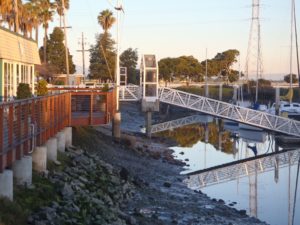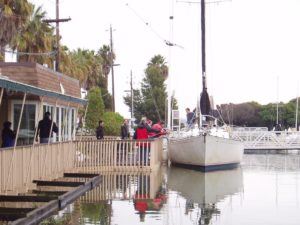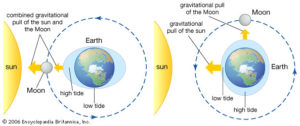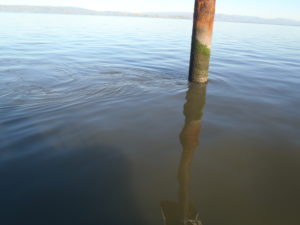Tides and Currents: by Bob Diamond
 It’s often said about sailing in San Francisco Bay, “If you can sail in San Francisco Bay, you can sail anywhere.” Although an exaggeration, our bay is a challenging place to sail not only because of its strong wind and choppy water but also because of the actions of tides and currents. At Redwood City, we can see a tidal range greater than 10 feet on a regular basis. Straying outside of the channel at high water on one of these days can leave a boat and crew high and dry for many uncomfortable
It’s often said about sailing in San Francisco Bay, “If you can sail in San Francisco Bay, you can sail anywhere.” Although an exaggeration, our bay is a challenging place to sail not only because of its strong wind and choppy water but also because of the actions of tides and currents. At Redwood City, we can see a tidal range greater than 10 feet on a regular basis. Straying outside of the channel at high water on one of these days can leave a boat and crew high and dry for many uncomfortable hours. It’s easier to go
hours. It’s easier to go
aground during low tides but at least you won’t get stuck for as long as when grounding at higher tide.
Tidal current is a different issue. The flow of the water has a great effect on a boat’s speed, especially sailboats that don’t go very fast to begin with. Imagine a sailboat that goes 5 knots in a 2.5 knot current. This is about as extreme as it gets in the South Bay. Sailing with the current will result in a 7.5 knot speed over the ground. Against the current will result in 2.5 knots. There’s a threefold increase in speed when sailing with the current compared to against it. That also means it’ll take three times longer to get somewhere sailing against the current than with it.
Tides
Tides are caused by the gravitational interaction of the moon and the sun acting on the earth and the oceans. Strictly speaking, tide only refers to the height of the water while current refers to the horizontal movement of water. The moon exerts a greater effect than the sun, not because its gravity is stronger than the sun’s gravity, but because the moon is so much closer to earth.
One of the laws of gravity is that the greater the distance between two masses, the less gravitational pull between them. So, the moon’s gravity pulls the strongest on the side of the earth closest to the moon. It also pulls on the earth itself, but not quite so much. It pulls on the ocean on the opposite side of the earth the least. This creates a high tide on the ocean simultaneously on the side of the earth facing the moon and on the side facing away. The tides are lowest on the sides of the earth facing 90º from the moon.
Meanwhile, the earth is rotating (one full rotation every day) so the side of the earth facing the moon is constantly changing. It takes a little longer than a 24 hour day for the same part of the earth to pass beneath the moon. This is because the moon is orbiting around the earth even as the earth rotates. The result is approximately two high and two low tides every day.
The sun’s gravity acts the same way but often from a different direction. This tends to amplify or diminish the tides caused by the moon, depending on the angle created by the sun, the moon and the earth. When the 3 bodies line up — during times of full moons and new moons — the gravity from the sun and moon combine to create higher-than-average tides. The time of the month when tidal range is the greatest is called Spring Tide or King Tide. When there is a quarter moon, the gravity of the sun and moon work against each other and we get lower-than-average tidal range. This is called Neap Tide.
The movements of sun, moon and earth are very consistent so someone with enough mathematical understanding can predict the tides well into the future. The shape of the land around the oceans distorts the height and the timing for specific locations, but even this is predictable once a particular area is understood. The timing and height differences are more distorted inside San Francisco Bay than on the outer coast. In Redwood City Harbor for example, high water is about an hour later than at the Golden Gate and 2.2 feet higher. Low water is about an hour and a half later and a tenth of a foot higher.
It happens that on the west coast of North America, the two daily high tides differ from each other, and so do the two low tides. This condition is called a mixed diurnal tide. (Tide clocks available in boating stores are designed to work on the East Coast, where the daily highs and lows more closely match each. These clocks don’t work very well on the West Coast.)
Current
Since San Francisco Bay is connected to the ocean through the Golden Gate, the bay water tends to rise whenever the ocean tide is going up, but this is only possible because of the current bringing in the water to fill the bay. Current coming from the sea is called flood current. It’s called ebb current when the water flows out toward the sea. This is caused by the falling tide and also as a result of river outflow. At the Golden Gate, the ebbing current will flow in excess of 4 knots just from tide falling 7 feet. Further inside the bay, the current is generally not as strong. In the South Bay between the Redwood City Channel and the San Mateo Bridge, the current is about half of what it is at the Gate. The timing also differs from the Golden Gate, but near the San Mateo Bridge the difference isn’t significant.
Tide and current predictions are available online and booklets available from various local sources. But what really happens is not always what is predicted. Wind can change predicted tides and currents significantly. Lots of rain can have a huge affect on current due to runoff. During periods of heavy rain, a flood tide at the Gate can be reduced to zero and the ebb can be enhanced to well more than 6 knots. Pity the poor sailor who has to fight to get into the Bay during a 6 knot ebb on a boat that can only go 5 knots!
When sailing in the South Bay, the current isn’t as critical as it is near the Golden Gate but it’s still very important. Most of the time, sailing in the bay off Redwood City involves either sailing directly with the current or directly against it. This makes it easy to calculate the effect of current either by adding the rate of current or subtracting it from your boat’s speed. A sail from Redwood City to San Francisco and back is possible on a day when the current ebbs in the morning and floods in the afternoon. When the currents are opposite you’d be lucky to get even half way.
The details here scratch only the surface of understanding tide and current. Dealing with current as a navigator involves more than sailing with or against it. These skills are taught in the Coastal Navigation class. The “current sailing” portion of the Coastal Navigation class uses a charting technique that enables navigators to calculate the precise headings needed to sail in a straight line to a destination despite current coming in any direction. Speed of advance can also be calculated despite any amount of current coming in any direction. Spinnaker Sailing offers Coastal Navigation. Click here for more information.


